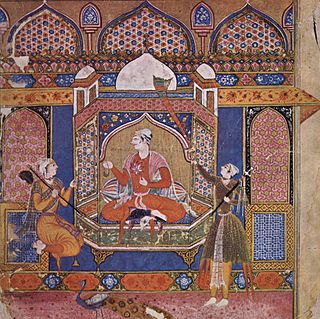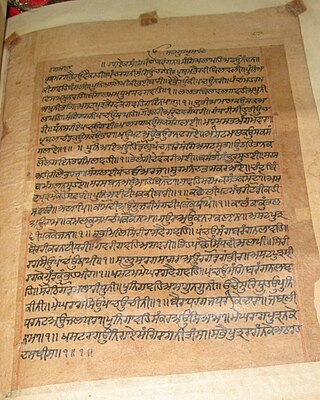
Gauri is an India musical raga that appears in the Sikh tradition from northern India and is part of the Sikh holy scripture called Sri Guru Granth Sahib. Every raga has a strict set of rules which govern the number of notes that can be used; which notes can be used; and their interplay that has to be adhered to for the composition of a tune. there are Gouris of the Bhairav, Poorvi and Marwa thats with additional qualifiers such as the Shree-anga Gouri, Bhairav-anga Gouri, Poorvi-anga Gouri and so on. These are not considered ‘big’ ragas.

The Guru Granth Sahib is the central holy religious scripture of Sikhism, regarded by Sikhs as the final, sovereign and eternal Guru following the lineage of the ten human gurus of the religion. The Adi Granth, its first rendition, was compiled by the fifth guru, Guru Arjan (1564–1606). Its compilation was completed on 29 August 1604 and first installed inside Golden Temple in Amritsar on 1 September 1604. Baba Buddha was appointed the first Granthi of the Golden Temple. Shortly afterwards Guru Hargobind added Ramkali Ki Vaar. Later, Guru Gobind Singh, the tenth Sikh guru, added hymns of Guru Tegh Bahadur to the Adi Granth and affirmed the text as his successor. This second rendition became known as the Guru Granth Sahib and is also sometimes referred to as the Adi Granth.

Sikh music, also known as Gurbani Sangeet , and as Gurmat Sangeet, or even as Shabad Kirtan, is the classical music style that is practised within Sikhism. It exists in institutional, popular, and folk traditions, forms, and varieties. Three types of Sikh musicians are rababis, ragis, and dhadhis. Sikh music exists in various melodic modes, musical forms, styles, musicians, and performance contexts.
Svara is a word that connotes simultaneously a breath, a vowel, the sound of a musical note corresponding to its name, and the successive steps of the octave or saptaka. More comprehensively, it is the ancient Indian concept about the complete dimension of musical pitch. Most of the time a svara is identified as both musical note and tone, but a tone is a precise substitute for sur, related to tunefulness. Traditionally, Indians have just seven svaras/notes with short names, e.g. saa, re/ri, ga, ma, pa, dha, ni which Indian musicians collectively designate as saptak or saptaka. It is one of the reasons why svara is considered a symbolic expression for the number seven.
Raga Asa is peculiar raga of Gurmat Sangeet Tradition. It is not being used in Indian music. There is a raga 'Majh Khamaj' in Hindustani Sangeet, but it does not resemble Asa of Gurmat Sangeet. Gurmat Sangeet is a musicology of Sikh Sacred Music, used in the Sikh holy scripture the Guru Granth Sahib. The ragas used by Sikh Gurus for Gurbani are known as Gurmat Sangeet. It is popular in the Sikh tradition from northern India and is part of daily prayers being conducted in Sikh Gurdwaras. Every raga has a strict set of rules which govern the number of notes that can be used; which notes can be used; and their interplay that has to be adhered to for the composition of a tune.

This is an India musical raga (composition) that appears in the Sikh tradition from northern India and is part of the Sikh holy scripture called Sri Guru Granth Sahib or Guru Granth Sahib for short. Every raga has a strict set of rules which govern the number of notes that can be used; which notes can be used; and their interplay that has to be adhered to for the composition of a tune. In the Guru Granth Sahib, the Sikh holy Granth (book) there are a total of 31 raga compositions and this raga is the ninth raga to appear in the series. The composition in this raga appear on a total of only 2 pages from page numbers 719 to 721.

Bihagara is an Indian musical raga (composition) that appears in the Sikh tradition from northern India and is part of the Guru Granth Sahib. Every raga has a strict set of rules which govern the number of notes and their interplay that has to be adhered to for the composition of a tune. The Guru Granth Sahib consists of 60 ragas and this is the twenty-second raga to appear in the series. The composition in this raga appears from page 537 to 557.

Shree is a very old North Indian raga of the Purvi thaat, and has traditionally been associated with Shiva. It also appears in the Sikh tradition from northern India, and is a part of the Guru Granth Sahib, the holy text of the Sikhs. The Guru Granth Sahib composition comprises 31 ragas where Shree is the first raga to appear. The raga appears first on 14th page of the composition.

Basant or Vasant is a Hindustani classical raga.

Bilaval or Bilawal is a raga and the basis for the eponymous thaat in Hindustani classical music. Raga Bilaval is named after Veraval, Gujarat.

Devagandhari is a raga in Indian classical music. In carnatic classical music, Devagandhari is a janya raga, whose melakarta raga is Shankarabharanam, 29th in the 72 Melakarta raga system. This is not to be confused with Karnataka Devagandhari, which is a janya of Kharaharapriya similar to Abheri.

Dhanashree is a raga. It prominently appears in the Sikh tradition from northern India and is part of the Guru Granth Sahib.

This is an India musical raga (composition) that appears in the Sikh tradition from northern India and is part of the Guru Granth Sahib. Every raga has a strict set of rules which govern the number of notes that can be used; which notes can be used; and their interplay that has to be adhered to for the composition of a tune.
Raga Bihag is a Hindustani classical raga belonging to the Bilawal thaat. It is a melodious Raga for beginners as well as experts. Raga Bihag uses all seven music swars. In Bihag, both the Madhyams are used. The Shuddha Madhyam is more prominent; TeevraMadhyama is only used with Panchama in the phrase PA MA' GA MA GA.

Ragmala, alternatively spelt as Raagmala or Ragamala, is a composition of twelve verses, running into sixty lines that names various ragas, which appears in most saroops of Guru Granth Sahib after the compositions of Guru Arjan entitled Mundavani.
Jaijaivanti or Jaijaiwanti is a Hindustani classical raga belonging to Khamaj Thaat. According to the Guru Granth Sahib, this raga is a mixture of two others: Bilaval and Sorath. The raga appears in the latter section in Gurbani, as only four hymns were composed by Guru Tegh Bahadur, the ninth Sikh guru. These hymns were added by his son and successor Guru Gobind Singh in 1705 A.D. This raga is not mentioned in any Indian classical scriptures on music nor in the Ragmala.

Shabad Hazare, also known as Sabad Patshahi 10, under the title Shabad, are ten religious hymns composed by Guru Gobind Singh that are present in Dasam Granth. These hymns have comments on ritualistic practices in Sanyas, Jogis and Bairagis, and also against any form of idolatry, human or deity worship.
Suhi, a very old North Indian raga.: it also appears in the Sikh tradition from northern India and forms part of the Guru Granth Sahib. In the Guru Granth Sahib, the composition appear in 62 ragas and this is the thirty first raga to appear in the series. The composition in this raga first appear on Ang number 728.
Jaitsri is an Indian classical raga that appears in the Sikh tradition from northern India and is part of the Guru Granth Sahib. It provided the setting for hymns by Guru Ram Das, Guru Arjan and Guru Tegh Bahadar for a total of 30 hymns.
Nat Bhairav is a Hindustani classical heptatonic (Sampurna) raga of Bhairav Thaat. Traditionally it is a morning raga. It is one of the most important ragas of the Bhairav anga.














